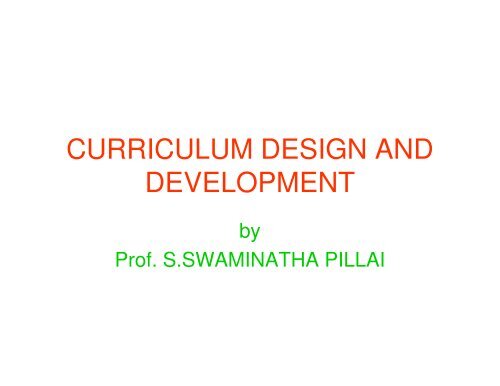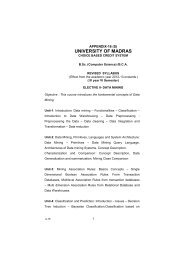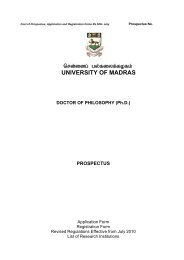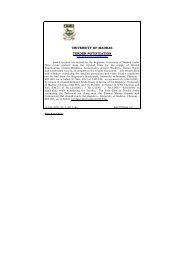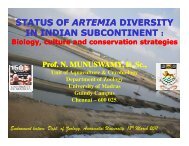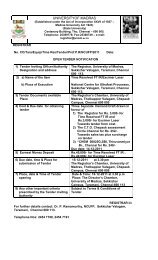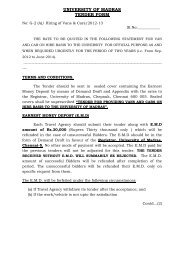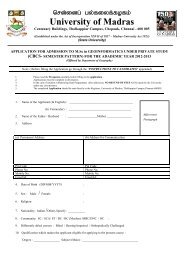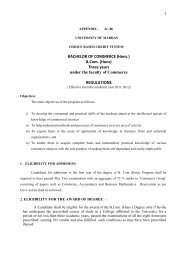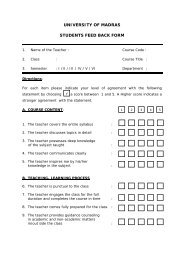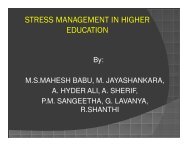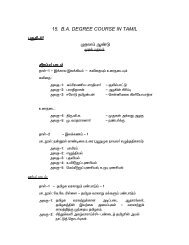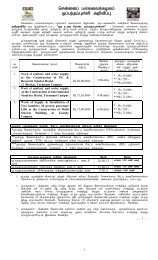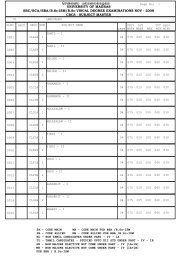curriculum design and development-1
curriculum design and development-1
curriculum design and development-1
You also want an ePaper? Increase the reach of your titles
YUMPU automatically turns print PDFs into web optimized ePapers that Google loves.
CURRICULUM DESIGN ANDDEVELOPMENTbyProf. S.SWAMINATHA PILLAI
DEFINITIONS OF CURRICULUM• That which is taught in schools• A set of subjects.• Content• A program of studies.• A set of materials• A sequence of courses.• A course of study• A set of performance objectives
• Everything that goes on within the school,including extra-class activities, guidance, <strong>and</strong>interpersonal relationships.• Everything that is planned by school personnel.• A series of experiences undergone by learnersin a school.• That which an individual learner experiences asa result of schooling.• An aggregate of courses of study in a schoolsystem.
• An aggregate of courses of study in a schoolsystem.• Planned <strong>and</strong> unplanned concept, content, skills,work habits, means of assessment, attitudes <strong>and</strong>instructional strategies taught in the classroom<strong>and</strong> the variety of school activities in <strong>and</strong> out ofclass that influence present <strong>and</strong> futureacademic, social, emotional <strong>and</strong> physical growthof students
DERIVING A DEFINITION• CURRICULUM IS A COMPREHENSIVEPLAN FOR AN EDUCATIONAL/TRAINING PROGRAMME/COURSE TOOFFER NEW/IMPROVED MANPOWERTO FULFIL THE RISING NEEDS OF ADYNAMIC SOCIETY.
KINDS OF CURRICULUM(according to the four families of learning theories)• Social,• Information Processing,• Personalist, <strong>and</strong>• Behavioral.
• child-centered,ORIENTATIONS TO• society-centered,CURRICULUM• knowledge-centered, or• eclectic.
Educational Philosophy• What is knowledge <strong>and</strong> underst<strong>and</strong>ing?• What is worth knowing?• What does it mean to learn?• How do you know that learning has taken place?• What should be the role of a teacher?• What should be the role of the student?• What is the ultimate purpose of education?• What are your core educational values?
APPROACHES TO CURRICULUM(Common philosophical orientations)• Idealism,• Realism,• Perennialism,• Essentialism,• Experimentalism,• Existentialism,• Constructivism,• Reconstructivism
Idealism• Subjective Idealism, only ideas can be known or have any reality (also known assolipsism).• Transcendental Idealism, developed by Kant, this theory argues that all knowledgeoriginates in perceived phenomena which have been organized by categories.• Absolute Idealism, all objects are identical with some idea <strong>and</strong> the ideal knowledgeis itself the system of ideas. It is also Objective Idealism, in this monistic idealismpromoted by Hegel there is only one mind in which reality is created.• Platonic Idealism, there exists a perfect realm of Form <strong>and</strong> Ideas <strong>and</strong> our worldmerely contains shadows of that realm.merely contains shadows of that realm.• Idealism believes in refined wisdom; reality is a world within aperson's mind; truth is in the consistency of ideas <strong>and</strong> goodness isan ideal state to strive to attain.• As a result, schools exist to sharpen the mind <strong>and</strong> intellectualprocesses. Students are taught the wisdom of past heroes.
Realism• Classical realism held universals such as "red" or "man" an independent, objectiveexistence, either in a realm of their own or in the mind of God.• Medieval realism, contrasted with Nominalism, provided by Peter Abelard <strong>and</strong> Williamof Occam.• Modern realism is a broad term, encompassing several movements whose unity liesin a common rejection of philosophical Idealism.• Realism asserts that objects in the external world exist independently of what isthought about them.• The most straightforward of such theories is usually known as naive realism.• The most straightforward of such theories is usually known as naive realism.• Realism believes in the world as it is. It is based on the viewthat reality is what we observe. It believes that truth is what wesense <strong>and</strong> observe <strong>and</strong> that goodness is found in the order ofthe laws of nature.• As a result, schools exist to reveal the order of the world <strong>and</strong>universe. Students are taught factual information.
Perennialism• (1) Permanence is more real than change.• (2) Human nature remains essentially the same.• (3) The good life -- the life that is fit for men to live -- remains essentially the same.• (4) Moral principles remain essentially the same.• (5) Hence, the education that men receive should remain essentially the same.• "Education implies teaching. Teaching implies knowledge. Knowledge is truth.The truth everywhere is the same. Hence, education should be everywhere thesame."• This is a very conservative <strong>and</strong> inflexible philosophy of education. It isbased on the view that reality comes from fundamental fixed truthsespeciallyrelated to God. It believes that people find truth throughreasoning <strong>and</strong> revelation <strong>and</strong> that goodness is found in rationalthinking.• As a result, schools exist to teach reason <strong>and</strong> God's will. Students aretaught to reason through structured lessons <strong>and</strong> drills.• Socratic dialogue. E.g. R.Hutchins, M. Adler
Essentialism• Essentialism is a uniquely American philosophy ofeducation which began in the 1930’s <strong>and</strong> 1940’s as areaction to what was seen as an overemphasis on achild-centered approach to education <strong>and</strong> a concern thatstudents were not gaining appropriate knowledge inschools.• The two origins of essentialism are idealism <strong>and</strong> realism.• Essentialists believe that there exists a critical core ofinformation <strong>and</strong> skill that an educated person must have.• Didactic Instruction. e.g., W. Bagely, W. Bennett.
Experimentalism• Experimentalism believes that things areconstantly changing. It is based on the view thatreality is what you experience. It believes thattruth is what works right now <strong>and</strong> that goodnesscomes from group decisions.• As a result, schools exist to discover <strong>and</strong> exp<strong>and</strong>the society we live in. Students study socialexperiences <strong>and</strong> solve problems.
Existentialism• Existentialism believes in the personalinterpretation of the world. It is based on theview that the individual defines reality, truth <strong>and</strong>goodness.• As a result, schools exist to aid children inknowing themselves <strong>and</strong> their place in society.• Students learn what they want <strong>and</strong> discusssubjects freely.• Creative self-directed choices. Discoverylearning. E.g. A.S. Neil
Constructivism• Learning is simply the process of adjusting ourmental models to accommodate newexperiences.• Learning is a search for meaning. Meaningrequires underst<strong>and</strong>ing wholes as well as parts.In order to teach well, we must underst<strong>and</strong> themental models that students use to perceive theworld The purpose of learning is for an individualto construct his or her own meaning, not justmemorize the “right” answers <strong>and</strong> regurgitatesomeone else’s meaning
Reconstructivism• Focus is on providing students the critical tools to be agents of socialchange. Students explore controversial issues, analyze world events. E.g.P. Freire.• Progressivism: The goal is to help each student think rationally. Studentcenteredapproach. Project <strong>and</strong> problem-based learning. E.g. John Dewey• Postmodernism: Focus on helping students recognize that here are nouniversal truths, <strong>and</strong> the traditional narratives of the dominant culture mustbe deconstructed. Deconstruction through dialogue. Critical pedagogy. E.g.M. Foucault.• Behaviourism: Free will is an illusion, students' behaviour is shaped in orderto reinforce proper learning <strong>and</strong> behavior. Drill <strong>and</strong> practice. B.F. Skinner
TYPES OF CURRICULUM• 1.Overt, explicit, or written <strong>curriculum</strong>• 2.Societal <strong>curriculum</strong>• 3. The hidden or covert <strong>curriculum</strong>• 4.The null <strong>curriculum</strong>• 5.Phantom <strong>curriculum</strong>• 6.Concomitant <strong>curriculum</strong>• 7.Rhetorical <strong>curriculum</strong>
• 8.Curriculum-in-use• 9.Received <strong>curriculum</strong>• 10. The internal <strong>curriculum</strong>• 11.The electronic <strong>curriculum</strong>• 12.Competency Curriculum
Overt, explicit, or written<strong>curriculum</strong>• that which is written as part of formal instructionof schooling experiences.• refers to a <strong>curriculum</strong> document, texts, films, <strong>and</strong>supportive teaching materials that are overtlychosen to support the intentional instructionalagenda of a school.• usually confined to those written underst<strong>and</strong>ings<strong>and</strong> directions formally <strong>design</strong>ated <strong>and</strong> reviewedby administrators, <strong>curriculum</strong> directors <strong>and</strong>teachers, often collectively.
Societal <strong>curriculum</strong>• Cortes defines this <strong>curriculum</strong> as themassive, ongoing, informal <strong>curriculum</strong> offamily, peer groups, neighborhoods,churches organizations, occupations,mass, media <strong>and</strong> other socializing forcesthat "educate" all of us throughout ourlives
The hidden or covert <strong>curriculum</strong>• That which is implied by the very structure <strong>and</strong> nature of schools,much of what revolves around daily or established routines.• the "hidden <strong>curriculum</strong>," which refers to the kinds of learningschildren derive from the very nature <strong>and</strong> organizational <strong>design</strong> of thepublic school, as well as from the behaviors <strong>and</strong> attitudes ofteachers <strong>and</strong> administrators - Longstreet <strong>and</strong> Shane• the emphasis on: sequential room arrangements; the cellular, timedsegments of formal instruction; an annual schedule that is stillarranged to accommodate an agrarian age; disciplined messageswhere concentration equates to student behaviors were they aresitting up straight <strong>and</strong> are continually quiet; students getting in <strong>and</strong>st<strong>and</strong>ing in line silently; students quietly raising their h<strong>and</strong>s to becalled on; the endless competition for grades, <strong>and</strong> so on.
The null <strong>curriculum</strong>• That which we do not teach, thus givingstudents the message that these elementsare not important in their educationalexperiences or in our society - Eisner
• the null <strong>curriculum</strong> is simply that which is not taught in schools.• Somehow, somewhere, some people are empowered to makeconscious decisions as to what is to be included <strong>and</strong> what is to beexcluded from the overt (written) <strong>curriculum</strong>.• Since it is physically impossible to teach everything in schools,many topics <strong>and</strong> subject areas must be intentionally excluded fromthe written <strong>curriculum</strong>.• the "null <strong>curriculum</strong>" is that when certain subjects or topics are leftout of the overt <strong>curriculum</strong>, school personnel are sending messagesto students that certain content <strong>and</strong> processes are not importantenough to study.• Unfortunately, without some level of awareness that there is also awell-defined implicit agenda in schools, school personnel send thissame type of message via the hidden <strong>curriculum</strong>.
Phantom <strong>curriculum</strong>• the enculturation of students into thepredominant meta-culture, or• acculturating students into narrower orgenerational subcultures.
Concomitant <strong>curriculum</strong>• What is taught, or emphasized at home, orthose experiences that are part of afamily's experiences, or relatedexperiences sanctioned by the family. (inthe context of religious expression,lessons on values, ethics or morals,molded behaviors, or social experiencesbased on the family's preferences.)
Rhetorical <strong>curriculum</strong>• comprised from ideas offered by policymakers,school officials, administrators, or politicians.• come from those professionals involved inconcept formation <strong>and</strong> content changes;• from those educational initiatives resulting fromdecisions based on national <strong>and</strong> state reports,public speeches,• from texts critiquing outdated educationalpractices.• also from the publicized works offering updatesin pedagogical knowledge.
Curriculum-in-use• The formal <strong>curriculum</strong> (written or overt)comprises those things in textbooks, <strong>and</strong>content <strong>and</strong> concepts in the district<strong>curriculum</strong> guides. However, those"formal" elements are frequently nottaught.• The <strong>curriculum</strong>-in-use is the actual<strong>curriculum</strong> that is delivered <strong>and</strong> presentedby each teacher.
Received <strong>curriculum</strong>• Those things that students actually takeout of classroom;• those concepts <strong>and</strong> content that are trulylearned <strong>and</strong> remembered.
The internal <strong>curriculum</strong>• Processes, content, knowledge combinedwith the experiences <strong>and</strong> realities of thelearner to create new knowledge. Whileeducators should be aware of this<strong>curriculum</strong>, they have little control over theinternal <strong>curriculum</strong> since it is unique toeach student.
The electronic <strong>curriculum</strong>• through searching the Internet for information, orthrough using e-forms of communication.• either formal or informal, <strong>and</strong> inherent lessonsmay be overt or covert, good or bad, correct orincorrect depending on ones' views.• both for recreational purposes (as in blogs,chatrooms, listserves, through instantmessenger on-line conversations, or throughpersonal e-mails) <strong>and</strong> for research <strong>and</strong>information,
• that part of the overt <strong>curriculum</strong> needs toinclude lessons on how to be wiseconsumers of information, how to criticallyappraise the accuracy <strong>and</strong> correctness ofe-information, as well as the reliability ofelectronic sources.
• how to be artfully discerning about theusefulness <strong>and</strong> appropriateness of certaintypes of information.• there are inherent lessons to be learnedabout appropriate <strong>and</strong> acceptable"netiquette" <strong>and</strong> online behavior,• include the differences between "fairusage" <strong>and</strong> plagiarism.
Competency Curriculum• Consists of competencies.• Assessment <strong>and</strong> certification ofachievement of the competencies issequentially integrated into each year ofthe <strong>curriculum</strong> culminating with acompetency transcript upon graduation
Medical <strong>curriculum</strong>
Nine Competencies of medical• I.Effective Communication• II.Basic Clinical skills<strong>curriculum</strong>• III.Using Science to Guide Diagnosis, Management, Therapeutics, <strong>and</strong>Prevention• IV.Lifelong Learning• V.Self-Awareness,Self-Care,<strong>and</strong> PersonalGrowth• VI.The Social <strong>and</strong> Community Contexts of Health Care• VII.Moral Reasoning <strong>and</strong> Ethical Judgment• VIII.Problem-Solving• IX.Professionalism <strong>and</strong> Role Recognition
LEVELS OF CURRICULUM• PRIMARY• SECONDARY: GENERAL ACADEMIC;OCCUPATIONAL/VOCATIONAL• TERTIARY: GENERAL ACADEMIC;PROFESSIONAL
INDIAN SCHOOL CURRICULUM• 2+ - 3+ : PLAY SCHOOL• 3+ - 5+ : PRE-SCHOOL• 5+ - 9+ : PRIMARY SCHOOL• 5+ - 12+:ELEMENTARY SCHOOL• 12+-14+:SECONDARY SCHOOL• 14+-15+:VOCATIONAL SKILLS CURRICULUM• 14+-16+:HR./SENIOR SEC. SCHOOL• 15+-18+:VOCATIONAL APPRENTICESHIP CURRICULUM• 16+-18+: VOCATIONAL DIPLOMA CURRICULUM• 16+-18+:U.G.CURRICULUM• 16+-19+:U.G.PROFL. (ENGG./TECH.)COURSE CURRI.• 16+-20+:U.G.MED. PROF. CURRI.• 18+-19+:P.G.CURRICULUM• 19+-20+:P.G. PROF.DIP. CURRI.• 20+-22+:P.G. PROF./GEN. RES. CURRICULUM• 22+-24+:DOCTORAL RESEARCH• 24+-26+:POST-DOCTORAL (D.Sc./D.Litt)/SUPER SPECIALITY
DETERMINANTS OF A• BASIC NEEDS• SOCIAL ASPECTSCURRICULUM• CULTURAL FACTORS• INDIVIDUAL TALENTS• IDEALS: INTELLECTUAL, MORAL, AESTHETIC,RELIGIOUS• TRADITIONAL
STAGES OF THE PROCESS• PLANNING• PREPARING• DESIGNING• DEVELOPING• IMPLEMENTING• EVALUATING• REVISING• IMPROVING
CURRICULUM PLANNING• PHILOSOPHY• SOCIAL FORCES, NEEDS, GOALS ANDOBJECTIVES• TREATMENT OF KNOWLEDGE• HUMAN DEVELOPMENT• LEARNING PROCESS & INSTRUCTION• DECISION
CURRICULUM PREPARATION• SYSTEMATIC, SYSTEMS• DATA, CONTENT• SELECTIONCOLLECTIONASSESSMENT• ORGANISATION
DESIGN FACTORS• SCHOOL (LEVELS, TYPES ,STRUCTURES)• EDUCATIONAL TECHNOLOGY• SYSTEMIC• VOCATIONAL• SOCIAL RECONSTRUCTION
CURRICULUM DESIGN• Analysis of social needs• Translating the needs intocourse/general/learning/terminal objectives• Splitting the objectives into specific objectives• Grouping the specific objectives into subjects• Deriving the subjects from the above classification• Specifying enabling objectives• Unitising each subject matter• Specification of required time• Syllabus formulation
CURRICULUM DEVELOPMENT-PHASES• INSTRUCTIONAL DEVELOPMENT• MATERIALS & MEDIA DEVELOPMENT• METHODS OF TEACHING & TESTING
Structure of a <strong>curriculum</strong>• Introduction• Scope• Aims & Goals• Courses of Studies: Part I, Part II, Part III Major,Ancillary, Part IV Alternative studies• Methodology• Materials• Media• Evaluation scheme• Outcome• World of work or Vista of life
CURRICULUM DEVELOPMENT• Relating the units of the subject matter tolearning resources• Choosing the appropriate strategies forcurricular transaction• Suggesting the suitable media• Exploring relevant learning experiences• Progressive testing of the achievement ofobjectives through these experiences
Structure of a syllabus• Role of the subject in the overall <strong>development</strong>• General & Specific objectives (Competences)• Content table: Unit No., Unit objecvtive, Enablingobjectives, unitised content,m Relevant resources,transactional strategies, learning experiences, using themedia, progressive self-testing items, time proposed froeach unit• Knowledge, Skill <strong>and</strong> Attitude proportion for materials• Methods & media• Testing• References• Linking with the other subjects in the <strong>curriculum</strong>
IMPLEMENTATION OF THECURRICULUM• Instructional scheme of each subject to becompleted in the semester.• Planning the lessons as per the timetable• Using the transactional strategies• Using the appropriate media• Providing the learning resources• Promoting classroom learning experiences• Progressive testing
CURRICULUM EVALUATION• Intra-curricular evaluation• Teacher evaluation of students• Student evaluation of teachers• Materials evaluation• Verification of methods• Evaluation of tests <strong>and</strong> examinations• Checking the learning outcomes while on the field• Curriculum review/ improvement/ change/ modification• System revision
What is evaluation?• Evaluation describes how to assess the nature,impact <strong>and</strong> value of an activity through thesystematic collection, analysis <strong>and</strong> interpretationof information with a view to making an informeddecision• Evaluation involves 3 activities:• o Outlining clear purposes• o Gathering evidences• o Judgment• Evaluation is part of <strong>development</strong> rather thanapart from it.
Curriculum Evaluation• Curriculum evaluation broadly conceived, is a stock-taking process.• A <strong>curriculum</strong> may be structured in so many ways. For instance,• -it may be based on an assembly of courses that are deemednecessary to meet certain job requirements;• - it can be formed from the basics of a particular discipline in afaculty or department;• - it can be <strong>design</strong>ed to meet the needs of a professional ortechnical programme,• - or it can be developed based on a systematic specification ofoutcomes.• It must therefore be periodically evaluated.
APPROACHES TO CURRICULUMEVALUATION• Goal-based• Determining whether pre-stated goals of educationalor training programs were met.• Goal-free• Uncovering <strong>and</strong> documenting what outcomes wereoccurring in educational or training programswithout regard to whether they were intendedprogram goals focus.• Responsive (contingency-unforeseen event)• Comparing what was intended for instruction towhat actually was observed.
• These approaches are based on the classical<strong>curriculum</strong> evaluation models as presentedby Stufflebeam <strong>and</strong> Shinkfield (1990)• The decision-making• The collecting information about educationalor training programs for the purpose ofdecision-making.• The accreditation• It is for forming professional judgmentsabout the processes used within educationor training programs.
• Curriculum evaluation ranges fromestimating the performance of a single childin a course through the evaluation of specificinstructional materials, methods, activities<strong>and</strong> techniques to the evaluation of an entire<strong>curriculum</strong>.• A comprehensive <strong>curriculum</strong> evaluation isconcerned with the worthwhilness of the<strong>curriculum</strong> components, <strong>and</strong> the informationprovided is for the sake of facilitativedecision making at the various stages of<strong>curriculum</strong> <strong>development</strong> (Alade, 2006)
Three paradigms or world viewsabout evaluation• Melrose (1996) grouped existing models into three paradigms or worldviews about evaluation, these are:• i. The functional model• ii. The transactional model; <strong>and</strong>• iii. The critical paradigms of evaluation.• The functional paradigm of evaluation usually measure the programme• outcomes against pre-stated goals;• the transactional paradigm focus is on whether or not the current,expressed needs of stakeholders, especially students as customers orclients have been met <strong>and</strong> whether the negotiated learning events have metthe participants’ satisfaction;• the critical paradigm of evaluation involves dialogue <strong>and</strong> collaborativeinvestigation whereby a focused question is agreed upon by the group foreach cycle of evaluationwhich may be small or broad in scope.• Evaluation thus become the systematic community learning processfor the collaborative review, improvement <strong>and</strong> <strong>development</strong> of polices,programmes <strong>and</strong> practices
ALADE’S SIX MODELS• From another perspective, Lawton (1980) citedin Alade (2006) classified models of <strong>curriculum</strong>evaluation into six, viz:• 1. The Classical Model• 2. Research <strong>and</strong> Development Model• 3. Illumination Model• 4. Briefing Decision-Makers Model• 5. Teacher as Research (Professional) Model• 6. Case Study Model.
OLAITAN’S FOUR MODELS• In respect of vocational-technical education evaluation, Olaitan(1996)identified the following evaluation models which hadbeen employed by a good number of researchers.• They include:• the Illumination Model,• the Goal-Free Model,• the Context, (C) Input (I), Process (P) (CIPP) Model, <strong>and</strong>• The Transactional Model.• They had been found reliable as a guide for collectingevaluative data in <strong>curriculum</strong> evaluation.• While a volume of other evaluation models still exist in theavailable literature, the fact remains clear that a model presentsa mental picture of a conceptualization of the relationshipsassumed to exist among a set of phenomena, <strong>and</strong> how theparts of a whole framework affect each other (Alade, 2006).
CIPP Evaluation Model(CACIIPPEM)• Curriculum Adaptation of CIPP Evaluation Model(CACIIPPEM)• r - relevance• a - adequacy• s – suitability r d s x• x – Any other criteria• C• P• I• P• Figure 1: Curriculum Adaptation of CIPP EvaluationModel-CACIPPEM
Models of <strong>curriculum</strong> evaluation• Robert Stake’s countenance model (1967)• Scriven’s goal-free models (1970s)• Stenhouse research model• Tyler’s objectives model• Parlett <strong>and</strong> Hamilton’s illuminative model (1977)• Stake’s matrix for processing descriptive data• Eisner’s educational connoisseurship model• Stufflebeam’s CIPP model
Scriven’s goal-free model (1970s)• Introduced the term ‘formative’ <strong>and</strong> ‘summative’• Broaden perspective of evaluation• Evaluator should not know the educational program’sgoals in order not to be influenced by them• Evaluator therefore totally independent• Evaluator free to look at processes <strong>and</strong> procedures,outcomes <strong>and</strong> unanticipated effects• Methodology, the field is open to the hunter but he didhave a ‘lethal’ checklist of criteria for judging any aspectof the <strong>curriculum</strong>
Stenhouse’s research model(1970s)• Evaluation as part of <strong>curriculum</strong> <strong>development</strong>• Continuous cycle of formative evaluation <strong>and</strong> <strong>curriculum</strong>improvement at school level• Relationship between <strong>curriculum</strong> developer <strong>and</strong>evaluator is central• Curriculum developer offer solutions• Evaluator is the practical man who temper enthusiasmwith judgment• The developer is the investigator; teacher• Autonomous professional self-<strong>development</strong> through selfstudy• Study of others <strong>and</strong> testing ideas
Tyler’s objectives model• Tyler’s principle deals with evaluating theeffectiveness of planning <strong>and</strong> actions• Curriculum should be evaluated in relation to itspre-specified set of objectives• Requires an objectives-based <strong>curriculum</strong> model• Evaluation measures fit between studentperformance <strong>and</strong> objective• Methodology will depend on the evaluator’sdefinition of ‘measurement’ (st<strong>and</strong>ard setting)
Stufflebeam CIPP model• CIPP model of <strong>curriculum</strong> <strong>development</strong> isa process of developing the <strong>curriculum</strong>.• CIPP model of <strong>curriculum</strong> evaluation is the• CIPP model of <strong>curriculum</strong> evaluation is theprocess to see the effectiveness of thedeveloped <strong>and</strong> implemented <strong>curriculum</strong>.
• These approaches are based on the classical<strong>curriculum</strong> evaluation models as presentedby Stufflebeam <strong>and</strong> Shinkfield (1990)• o The decision-making• The collecting information about educationalor training programs for the purpose of decisionmaking.• o The accreditation• It is for forming professional judgmentsabout the processes used within education ortraining programs.
Stufflebeam CIPP model• Context• Planning decisions• What needs are to be addressed• Defining objectives for the program• Input• Structuring decisions• What resources are available• What alternative strategies should beconsidered• What plan has the best potential
• Process• Implementing decisions• How well is the plan being implemented• What are the barriers• What revision are needed• Product• Recycling decisions• What result are obtained• Were need reduced• What should be done with the program
Context evaluation• Most basic kind of evaluation• Objective• To define the context• Identify population• Assess needs• Diagnose problem• Method: system analysis, survey, documentreview, hearing, interview, tests, Delphi(Wiseman technique)
• Relation to decision-making• Decide on setting• Goals <strong>and</strong> objectives• Planning• Providing basis for judging outcomes• Provides rationales for determining objectives• Uses experiential <strong>and</strong> conceptual analysis,theory, authoritative opinion to judge basicproblems which must be solved•
Input evaluation• Objective• Identify <strong>and</strong> assess system capabilities• Alternative strategies• Implementation <strong>design</strong>• Budget• Method: resources analysis, feasibility analysis, literatureresearch, exemplary program visits <strong>and</strong> pilot projects• Decision• Selecting sources• Structuring activities• Basis for judging implementation
Process evaluation• Objective• Identify/predict defects in <strong>design</strong> or implementation <strong>and</strong> record<strong>and</strong> judge procedural activities• Method: monitoring, describing process, interacting, observing• Decision:• For implementing <strong>and</strong> refining program <strong>design</strong> <strong>and</strong> procedures• Process control• Information to use in interpreting outcomes• Provides periodic feedback to those responsible for implementation• Maintain a record of procedures as they occur
Product evaluation• Objective• Describe <strong>and</strong> judge the outcome• Relate them to objectives• Interpret worth• Method: operationally measuring criteria, collectingstakeholder judgment• Decision• To continue• Terminate• Modify• Refocus• And present record of effects
• Purpose to measure <strong>and</strong> interpretattainment at end of project cycle• Operationally measures objectives <strong>and</strong>compare to predetermined st<strong>and</strong>ards• Interpret outcomes using context, input<strong>and</strong> process information.
Steps in CIPP model• Focus the evaluation• Collect information• Organize information• Analyze information• Report information• Administration of the evaluation report
CURRICULAR CHANGES• NATIONAL ASPIRATIONS AND NEEDS• CUTURAL CHANGES• SOCIAL CHANGES: TECHNOLOGICALDEVELOPMENT, ECONOMIC CHANGES, POLITICALVARIATION, CHANGES IN VALUES• VALUE SYSTEM• PHILOSOPHICAL,SOCIOLOGICAL,PSYCHOLOGICAL APPROACHES
A SIX-STEP APPROACHEVALN. &FEEDBACKPROBLEMID &NEEDSASSESSIMPLEMENT-ATIONNEEDSASSESSMENTOFLEARNERSEDUCATIONALSTRATEGIESSPECIFICMEASURABLEOBJECTIVES
Step 1: Problem Identification• Identify <strong>and</strong> characterize the SOCIALproblem• Know what we are talking about
Step 2: Needs Assessment of Learners• Know• who our target audience is <strong>and</strong>• what out target audience needs
Step 3: Goals <strong>and</strong> Objectives• Identify the end toward which an effort isdirected• Goals• Objectives –specific <strong>and</strong> measurable(ASK)• Direct the choice of curricular content• Clearly communicate the purpose• Suggest what learning methods will bemost effective
Step 4: Educational Strategies• Identify the educational strategies bywhich the curricular objectives will beachieved. Involve both content <strong>and</strong>method.• Provide the means by which curricularobjectives are achieved
Step 5: Implementation• Identify sufficient resources, support, <strong>and</strong>others to successfully implement the<strong>curriculum</strong>
Step 6: Evaluation <strong>and</strong> Feedback• Describe the plan to evaluate theeffectiveness of the <strong>curriculum</strong>• Closes the loop• Provides information about continuousquality improvement
A SIMPLIFIED SYSTEMS APPROACH TOCOURSE DESIGN
Small Group Activity• Step 1:• What is the SOCIAL problem we need to address?• Step 2:• What methods should we employ to obtain the needs assessmentinformation we need?• What do you think are these needs?• Step 3:• Identify the end toward which an effort is directed• Goals• Objectives –specific <strong>and</strong> measurable (ASK)• Direct the choice of curricular content• Clearly communicate the purpose• Suggest what learning methods will be most effective
Small Group Activity• Step 4• What’s included in our content?• What educational strategies should we employ (e.g.lecture-discussion, lab, case-based, etc.)?• Step 5:• Who, what, where are our resources to support the<strong>curriculum</strong>• Step 6:• How will we evaluate the program <strong>and</strong> our residents?
FLOWCHART REPRESENTATION OF TABA-TYLER CURRICULUM DEVELOPMENT MODEL
THANK YOU• WISH YOU ALL THE BEST IN• WISH YOU ALL THE BEST INDEVELOPING A NEW CURRICULUM


